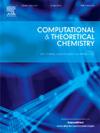掺铝联苯作为光气检测高效传感器的理论研究
IF 3
3区 化学
Q3 CHEMISTRY, PHYSICAL
引用次数: 0
摘要
光气(COCl₂)是一种剧毒气体,对人类健康和环境构成重大风险,因此对其进行检测和监测至关重要。在这项研究中,我们利用M062X/6-31G(d,p)水平的理论,探索了原始和掺铝联苯(BP)单层作为光气检测传感材料的潜力。铝掺杂破坏了BP的均匀电子密度,产生了活性位点,显著提高了其反应活性。虽然光气在原始BP上的吸附较弱,吸附能为- 6.93 kcal/mol,电子性质变化很小,但热化学分析证实了这种相互作用在标准条件下是非自发的。相比之下,掺杂al的BP单层膜(Al1-BP和Al2-BP)具有较强的光气吸附能力,吸附能分别为- 20.09 kcal/mol和- 21.47 kcal/mol。值得注意的是,光气吸附在掺杂单层上时,能隙发生了显著变化,并且该过程在热力学上是有利的,正如负自由能值所表明的那样。天然键轨道(NBO)分析表明,铝掺杂BP的灵敏度和反应性的增强是由于光气氧的孤对电子与铝掺杂的孤对电子的里德堡态相互作用所致。这些结果表明,掺铝BP单层膜作为光气检测的高灵敏度和高效率材料具有广阔的应用前景。本文章由计算机程序翻译,如有差异,请以英文原文为准。

Theoretical investigation of Al-doped biphenylene as efficient sensor for phosgene detection
Phosgene (COCl₂) is a highly toxic gas that poses significant risks to human health and the environment, making its detection and monitoring critically important. In this study, we explored the potential of pristine and aluminum-doped biphenylene (BP) monolayers as sensing materials for phosgene detection using the M062X/6-31G(d,p) level of theory. Aluminum doping was shown to disrupt the uniform electronic density of BP, creating active sites that significantly enhance its reactivity. While phosgene adsorption on pristine BP was weak, with an adsorption energy of −6.93 kcal/mol and minimal changes in electronic properties, thermochemical analysis confirmed that this interaction is non-spontaneous under standard conditions. In contrast, Al-doped BP monolayers (Al1-BP and Al2-BP) exhibited strong phosgene adsorption, with adsorption energies of −20.09 kcal/mol and −21.47 kcal/mol, respectively. Notably, a significant change in the energy gap was observed upon phosgene adsorption on the doped monolayers, and the process was found to be thermodynamically favorable, as indicated by negative free energy values. Natural bond orbital (NBO) analysis revealed that the enhanced sensitivity and reactivity of Al-doped BP arise from donor-acceptor interactions between the lone pair electrons of phosgene oxygen and the Rydberg state of lone pairs from the aluminum dopant. These results demonstrate the promising potential of Al-doped BP monolayers as highly sensitive and efficient materials for phosgene detection.
求助全文
通过发布文献求助,成功后即可免费获取论文全文。
去求助
来源期刊

Computational and Theoretical Chemistry
CHEMISTRY, PHYSICAL-
CiteScore
4.20
自引率
10.70%
发文量
331
审稿时长
31 days
期刊介绍:
Computational and Theoretical Chemistry publishes high quality, original reports of significance in computational and theoretical chemistry including those that deal with problems of structure, properties, energetics, weak interactions, reaction mechanisms, catalysis, and reaction rates involving atoms, molecules, clusters, surfaces, and bulk matter.
 求助内容:
求助内容: 应助结果提醒方式:
应助结果提醒方式:


